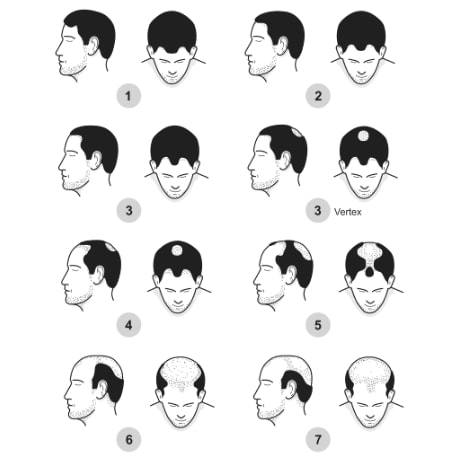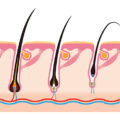Last updated on June 3, 2024
[starbox]
Experiencing hair loss in the beginning stages can often go unnoticed. Gradual thinning or a receding hairline may be difficult to detect, perhaps only noticeable to you, your mother, or your partner.
However, if left untreated, hair loss can progress to balding, particularly at the top of the head, especially in men. Naturally, concerns may arise about potential balding in the crown area.
Balding on the crown is a common occurrence, but there are methods to prevent and even reverse this type of hair loss.
Bald Spot on the Crown – Recognizing Early Signs of Hair Loss
A receding hairline is easily noticeable, but detecting a bald spot on the crown is not as straightforward. You might not even realize your hair is thinning until you feel the smoothness where hair used to be.
Spotting the bald spot can be challenging, as it is situated at the vertex of your head, making it difficult to observe without the aid of mirrors.
Nevertheless, a balding crown is among the earliest signs of male pattern baldness (MPB), also known as androgenetic alopecia.
While it may be disheartening to confirm the presence of a bald spot, acknowledging it is the first step toward prevention and treatment. The sooner you commence treatment, the more effective the outcomes can be.
Common Indicators of Early Balding
Thankfully, the early signs of balding are more discernible than that elusive, invisible point at the back of your head. By recognizing these signs, you may be able to identify hair loss before it progresses to baldness.
Thinning Hair
Thinning hair is an evident initial sign of balding. It can manifest as overall diffuse thinning across the entire head or localized thinning, primarily around the temples or the top of the head.
During the early stages, if your crown is thinning, you may not experience thinning on the sides or back of your head. In fact, it can take years for the crown to begin balding.
Thinning hair at the front of your head, specifically the hairline, can also indicate early stages of balding, particularly in males.
Receding Hairline
A prominent symptom of male pattern baldness, which can lead to a balding crown, is a receding hairline. This involves the hair at the front and sides of your head moving away or receding from your face.
Male pattern baldness follows a recognizable pattern, ultimately culminating in balding at the crown.
Understanding the Stages of Crown Balding
Crown balding typically progresses through various stages, allowing you to assess the extent of hair loss you may be experiencing. Clinically, men’s hair loss is measured using the Norwood Scale.
The Norwood Scale outlines seven stages of hair loss:
- Stage 1: No visible signs of balding or thinning hair.
- Stage 2: Mild receding hairline noticeable at the temples.
- Stage 3: Receding hairline becomes more apparent at the temples in an M, V, or U shape hairline. Bald spots may begin to develop. Alternatively, the hairline recession may remain mild but with significant crown balding.
- Stage 4: Hair loss is prominent on the top of the scalp, with a narrow band of hair connecting patches around the sides of the head.
- Stage 5: The band of hair further thins as areas of hair loss expand.
- Stage 6: Any remaining band of hair on the top of the scalp is almost or completely gone. Hair loss from the temples reaches the crown.
- Stage 7: The top of the head may be bald, while some hair may still be present at the back and sides.
Pictured: Norwood Scale
Causes of a Balding Crown
In most cases, a balding crown can be attributed to genetic factors. Hereditary hair loss, known as androgenetic alopecia or male pattern baldness (MPB), progresses gradually and is primarily caused by a hormone called dihydrotestosterone that shrinks hair follicles.
There are also a few other possible causes for a bald spot, including prescription medication and stress.
Genetic Balding
Genetics are the primary cause of a balding crown. Hereditary hair loss, also known as androgenetic alopecia or male pattern baldness (MPB), develops gradually due to the effects of dihydrotestosterone, a hormone that causes hair follicles to shrink.
Issues with Prescription Medication
Some prescription medications list hair loss as a potential side effect. Chemotherapy drugs are among the most common culprits, as they can trigger anagen effluvium hair loss.
Hair loss associated with chemotherapy can occur rapidly, typically within two weeks of starting treatment, but the progression becomes more noticeable after one or two months.
Other medications that may contribute to hair loss include weight loss medication, steroids, immunosuppressants, beta-blockers, non-steroidal anti-inflammatory drugs (NSAIDs), and thyroid medication.
Stress and Anxiety
Stress can manifest in various ways throughout the body, including hair loss in the form of a balding crown.
One type of stress-related hair loss is telogen effluvium, which often occurs due to a sudden, significant stressor on the body, such as illness or a family bereavement.
This condition can cause hair follicles to enter a resting phase prematurely, resulting in sudden hair shedding a few months later.
Regardless of whether hair loss is caused by genetics or external factors, there is good news—it can be reversed. The best way to determine the potential for regrowth is by initiating treatment.
Treating Your Bald Spot
If you notice minimal hair growth on your crown or detect early signs of hair loss, there’s no need to panic. You’ve already taken the crucial first step toward reversing your hair loss.
Here’s what you should do next:
Consult a Hair Loss Doctor
As soon as you observe hair thinning, take action by scheduling a consultation with our hair loss doctor. The earlier you begin treatment, the better your chances of success. Delaying treatment may result in permanent hair loss.
Our doctors can help you identify the root cause of your balding and provide a personalised treatment plan, tailored to your needs.









